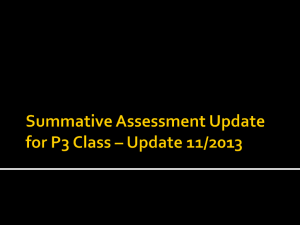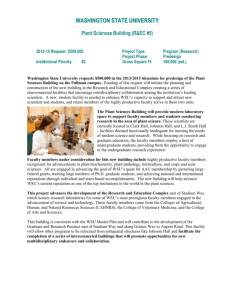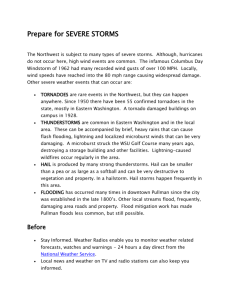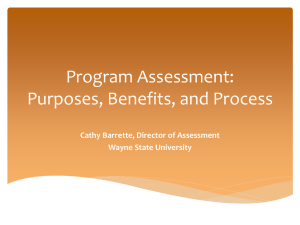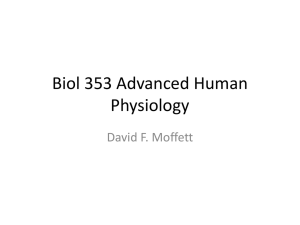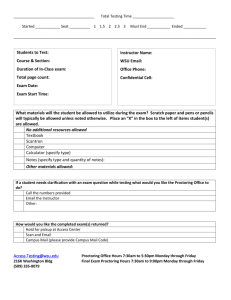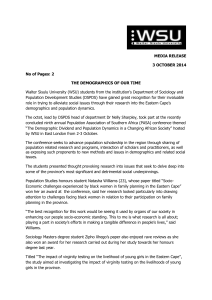Overall Strategy for Developing the University for the 21st Century
advertisement
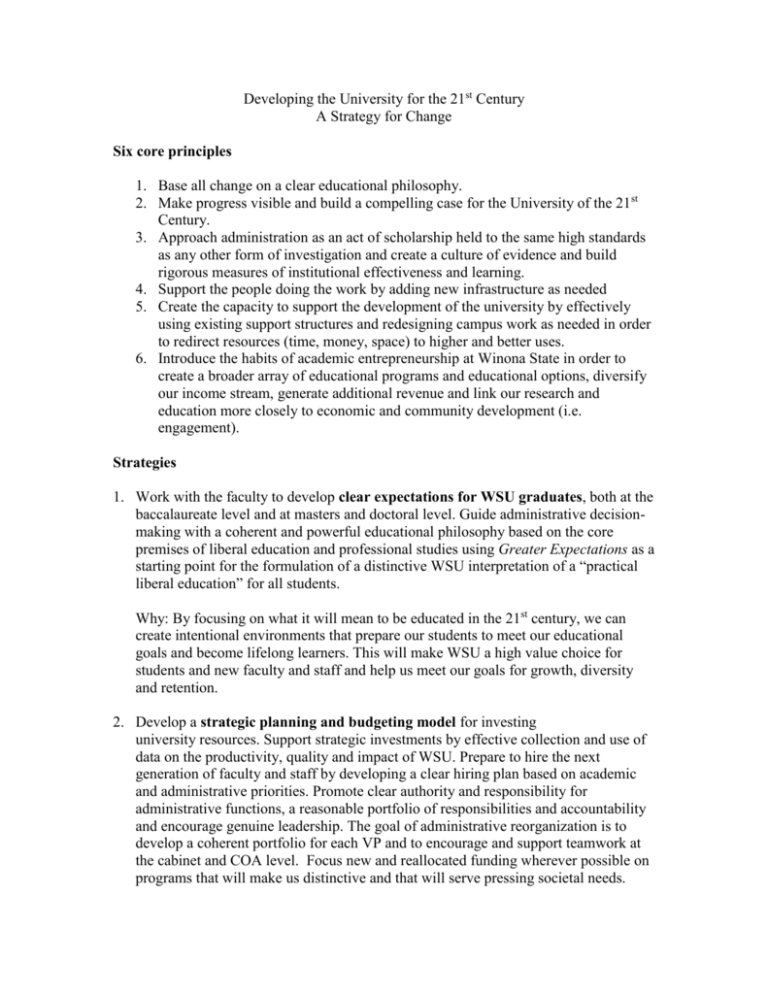
Developing the University for the 21st Century A Strategy for Change Six core principles 1. Base all change on a clear educational philosophy. 2. Make progress visible and build a compelling case for the University of the 21st Century. 3. Approach administration as an act of scholarship held to the same high standards as any other form of investigation and create a culture of evidence and build rigorous measures of institutional effectiveness and learning. 4. Support the people doing the work by adding new infrastructure as needed 5. Create the capacity to support the development of the university by effectively using existing support structures and redesigning campus work as needed in order to redirect resources (time, money, space) to higher and better uses. 6. Introduce the habits of academic entrepreneurship at Winona State in order to create a broader array of educational programs and educational options, diversify our income stream, generate additional revenue and link our research and education more closely to economic and community development (i.e. engagement). Strategies 1. Work with the faculty to develop clear expectations for WSU graduates, both at the baccalaureate level and at masters and doctoral level. Guide administrative decisionmaking with a coherent and powerful educational philosophy based on the core premises of liberal education and professional studies using Greater Expectations as a starting point for the formulation of a distinctive WSU interpretation of a “practical liberal education” for all students. Why: By focusing on what it will mean to be educated in the 21st century, we can create intentional environments that prepare our students to meet our educational goals and become lifelong learners. This will make WSU a high value choice for students and new faculty and staff and help us meet our goals for growth, diversity and retention. 2. Develop a strategic planning and budgeting model for investing university resources. Support strategic investments by effective collection and use of data on the productivity, quality and impact of WSU. Prepare to hire the next generation of faculty and staff by developing a clear hiring plan based on academic and administrative priorities. Promote clear authority and responsibility for administrative functions, a reasonable portfolio of responsibilities and accountability and encourage genuine leadership. The goal of administrative reorganization is to develop a coherent portfolio for each VP and to encourage and support teamwork at the cabinet and COA level. Focus new and reallocated funding wherever possible on programs that will make us distinctive and that will serve pressing societal needs. Free up funds for innovation and for redesign of essential programs. Aim for about 3% of our base in our innovation fund and work on ways to replenish that fund as the best projects get built into the base. Distribute the innovation funds in a competitive process through targeted RFPs. Why: We have to use every dime we have to maximum effect and use the resources we have wisely as well as coordinate investments so that any new funds are leveraged as much as possible by reallocation of existing funds and efforts. 3. Make intentional change at WSU an act of scholarship by applying an experimental approach to the development of the University for the 21st Century. Require a clear warrant for any intervention or change, supported by a culture of evidence. Learn from the process of experimentation and become a true learning organization infused with the capacities of a community of practice. Foster a habit of continuous learning and improvement. Turn WSU into a working model of a 21st century education in action (i.e. practice what we teach). Why: We have to build a 21st century university with very few new resources. So we must deploy time, space, equipment and budget wisely to enhance the quality and distinctiveness of WSU. We need to stand out from the crowd both among peers and among potential students and donors. 4. Move to high and rigorous standards for everything we do in administration. Build support for scholarship by expanding institutional research and assessment and linking it to a stronger graduate education and research function. Why: A best buy in the 20th century is most definitely NOT going to be a best buy in the 21st. WSU must become intentional, distinctive and effective if we are to remain competitive. Quality matters! 5. Connect WSU effectively to the broader community through productive collaborations and partnerships that focus on strategically important issues (such as entrepreneurship, quality of K-12 education, sustainability and renewable energy, health care, economic development, the arts). Use those connections to address economic and community development and to create realistic and important learning opportunities for our students in order to prepare them for life and work in the 21st century. Why: To gain the knowledge, connections and resources we need to accomplish our mission and to enhance the overall learning and innovative capacity of SE Minnesota. No institution can hope to accomplish its goals by standing alone. Our ability to achieve our mission depends upon not only our own resource base but also upon access to the resources and expertise of others. 6. Foster interdisciplinary work that connects the different parts of WSU to each other, especially the relationship between the Winona campus and the Rochester campus, the relationships between academic and student affairs, and relationships across fields and disciplines. Continue to connect our intercollegiate athletics program more closely to academic and student affairs. Use all of these connections to develop the capacity to find effective solutions for complex institutional and societal problems. Why: To create the capacity to create an exemplary educational environment that supports an outstanding student experience and that enhances the region. See strategy #2 and #5. 7. Connect WSU effectively to other MnSCU institutions and beyond through codesigned educational programs, joint economic and community development projects or programs and cooperation in seeking external funding. Why: To generate the intellectual and institutional relationships that we must have in order to achieve these strategies. 8. Convert WSU from a state-supported mindset (and its attendant culture of scarcity as state support drops) to an entrepreneurial institution that enjoys new, more diverse sources of external support generated by a stronger portfolio of grant support and an intentional set of educational offerings, both credit (improved retention rates, transfer programs, co-enrollments, summer and weekend/evening programs, expanded graduate programs) and non-credit (workshops, customized programs for particular communities or employers, special certificates in high demand areas developed with support from industry or community partners, etc). To this mix of instructionallygenerated support add a more robust advancement function and new external support from individual donors, corporations, private foundations, and Federal agencies (via earmarks and other sources). Prepare for a capital campaign and build up our Federal agenda. Why: We cannot assume an adequate state appropriation to help us build up WSU in keeping with this plan for strategic institutional improvements in quality and performance. 9. Expand international programming, both here and abroad in order to prepare our students to be globally competent. This strategy is based on the premise that excellence is only possible if we generate sufficient diversity (inclusive excellence). Why: We have a fairly regional and homogeneous population of students and lack sufficient diversity on our faculty and staff. To prepare our students for the real world, we have to bring the world to us in one way or another and take more of our students out into the world, even the world of SE Minnesota where growing diversity offers us a good opportunity to accomplish what we normally expect international exposure to achieve. 10. Develop UCR as a model of an inter-institutional collaboration that serves the needs of a non-traditional student body in Rochester. Why: Rochester is a wonderful working laboratory in which to explore and understand many emerging and important social, cultural and economic issues. It also has a large population base with a strong need for access to affordable and high quality educational options for an increasingly diverse community. We must tap that diversity and expand access in that market, especially for returning adults and for people seeking graduate degrees in the fields we support. 11. Place a special emphasis on effective communication and interaction, both within the institution and with our many external constituencies. Make a clear distinction between the development of ideas and messages and the production function that can represent those ideas compellingly both in cyberspace and in printed form. Approach the use of technology as a means to support effective communication and learning, a platform for fostering interactions and relationships and as a defining feature of the campus environment. Keep in mind that technology is a means to appropriate ends, not an end in its own right. Why: We are undertaking a dramatically different approach to institutional development and we must pay special attention to the need to help our many stakeholders understand what we are doing, why we are doing it and what we hope to accomplish. 12. It is time to practice the three R’s: Revenue enhancement, Restructuring and cost Reduction. At the same time, we must continuously improve the quality that students and communities can expect in return for their investment in postsecondary education. Why: By making changes in our campus operations, cost structure and academic programs, we can contain our costs, improve our productivity and minimize our dependence upon tuition increases to finance our core operations. We can also free up more resources to support the work of our community of learners. Judith Ramaley December 17, 2005 Revised December 20, 2005 Revised February 20, 2006 Final revision February 27, 2006
